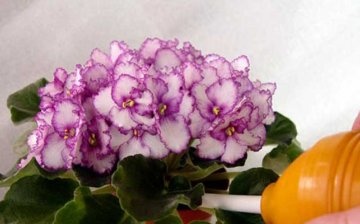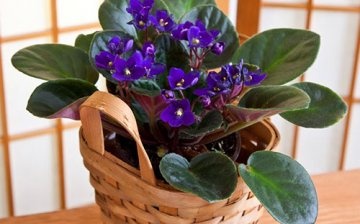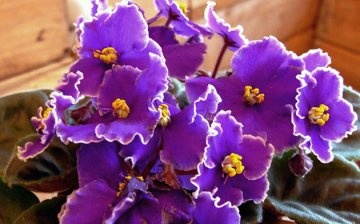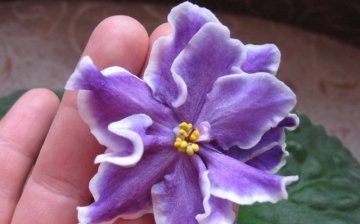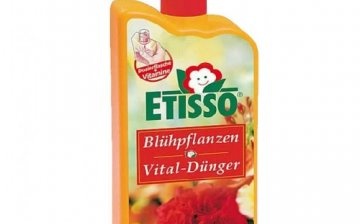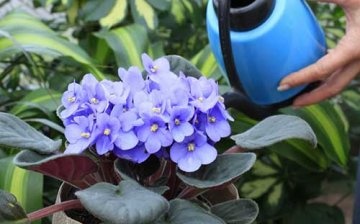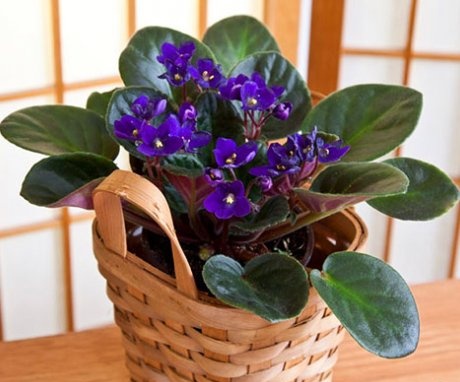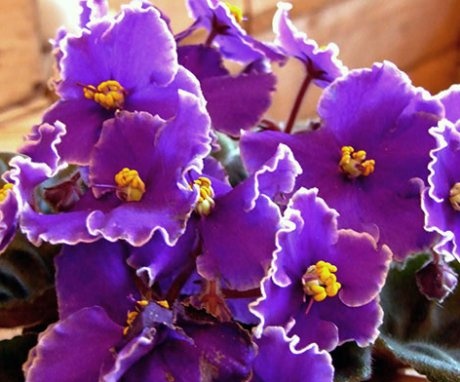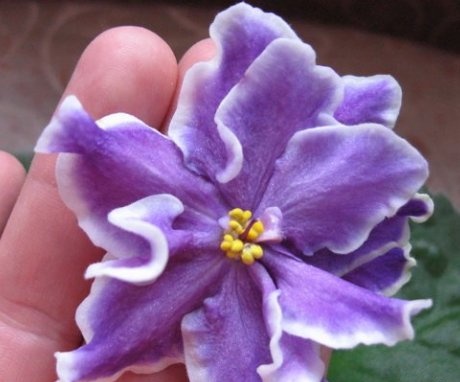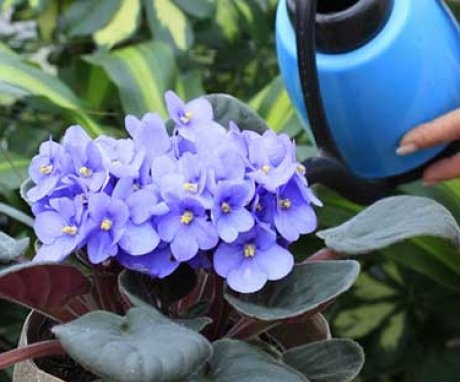Fertilizers for violets: types, methods and rules of application
Grow violet at home began not so long ago - at the beginning of the 20th century. Initially, these were simple flowers, capricious, but very beautiful. Later, the breeders did a great job and bred many hybrids and varieties, unpretentious and refined. The beauty of the violet amazes with a variety of colors and shapes. With its help, interiors are decorated, the plant takes part in a variety of flower arrangements.
The home violet can be taken out into the garden in the summer and decorated with it on verandas, attic and terraces. Ampel culture species are planted on balconies. But in order to grow a flower of rare beauty, it is necessary to clearly understand that there are many varieties that require different care and conditions of detention. Let's figure out which varieties are more often grown by flower growers at home and how to care for them.
Content:
- Choosing a variety of violets
- Plant care rules
- Top dressing is the key to lush flowering
- Top dressing methods
Choosing a variety of violets
Successful cultivation violets depends on which variety the florist wants to grow. The fact is that the plant has about 4,000 varieties. The number is huge and choosing the right kind of culture is not so easy. In order to navigate correctly in this "ocean" of varieties and hybrids, you should learn a simple classification of violets. It is worth starting from it.
Allocate:
- Collectible plants - large flowers, double and lush. This category of violets is meant to be grown for exhibitions and special occasions.
- Industrial species - these are the plants that are more often found in our home. They are not so whimsical and simpler in color and shape.
- Variegated varieties - these types of violets are distinguished by unusual greenery. It is bright and has a contrasting ornament on the leaves. Unpretentious.
- Ampel violets - grown for the purpose of landscaping vertical structures. Plants are unpretentious and grow quickly.
If you just want to try growing violets, then it is wiser to choose a variety from the industrial category. They are very easy to grow, they are unpretentious and very beautiful. For already experienced florists, a group of collection varieties is of course attractive. These are luxurious plants, but demanding in terms of growing conditions and maintenance.
Among such a huge variety of varieties, flower growers recommend paying attention to several types of violets. These varieties are very effective and quite unpretentious. Allocate:
- "Arctic Frost" is one of the most popular varieties. Flower growers like it because of its unpretentiousness, the plant can grow anywhere. The flowers are large, white and blue.
- "Bellay Snowcon" is a charming snow-white violet. A small bush is decorated with a cap of flowers, very similar to peduncles apple trees.
- "Centolia Aarone Pig" - the variety has an unusual color. Lilac specks are scattered against the lavender background. It looks very impressive. The flowers are quite large.
- "Sea wolf" - large blue flowers, double. Beautiful inflorescences are set off by juicy foliage of rich green color.
- "Beautiful Creole" - has a rare color. The bright blue petals of the flower are highlighted with a white border. An amazing sight.
- Variety "Nada" - very widespread among flower growers. The flowers are white-cream with rare specks.The plant is unpretentious and can be grown easily even by beginners.
All these violets do not require special growing conditions, but observe agricultural technology and the rules of leaving still have to. For example, the common rule not to pour water on the leaves and rosettes of a plant applies to these varieties as well. When choosing, try to be guided not only by the appearance of the flower, but also by what conditions of detention you can provide to him. In this case, growing violets will be interesting and successful.
Plant care rules
Before purchasing a violet, take care of the place where it will have to live. You cannot place the plant on the southern windows if it is a window sill. Direct sunlight is detrimental to the delicate leaves of the flower. The optimal direction is north or west. The room should have a lot of sunlight, diffused light. If, however, there are only southern windows, they must be shaded, for example, with gauze.
In winter, do not leave the plant on the windowsill. The hot air from the radiators and the cold from the windows will ruin the violet. You can install a screen from radiators and windows, and put the flowerpot on a wooden stand. It is better to place the flower pot a little further from the window so that the plant has enough light and it does not suffer from batteries and cold in winter. There should be no drafts in the room. The temperature of the content during the day is 21 ° -24 °, at night 18 ° -20 °.
Violet is very demanding not only for the place of keeping, but also for watering.
Do not allow water to come into contact with leaves and rosettes. Therefore, many growers immerse the pot in warm, settled water and leave it there for a while. Then they are taken out and allowed to drain off excess water. This is how watering... It is very important to take care of soil drainage initially. Moisture should not accumulate in the pot, otherwise root system will quickly rot. It is impossible to overdry the violet, the plant will quickly die. The faded flowers are carefully cut with a sharp knife or blade.
In addition to watering and maintaining conditions, the violet must be properly fed with fertilizers. The plant can be easily oversaturated, or vice versa, "starved". Therefore, it is important to understand the feeding scheme. It is not difficult, but it is advisable to stick to it.
Top dressing is the key to lush flowering
Any plant sooner or later needs additional nutrition - organic or mineral macro and microelements. After planting violets, the soil begins to deplete after a couple of months and the flower does not have enough nutrition. He begins to extract it from his own lower leaves in order to "feed" young rosettes. If feeding does not come, the plant begins to take food from the leaves of the middle row for the budding period. That is why you can observe yellow leaves of violets and slow growth.
Top dressing must be carried out without fail, they begin to do this two or a maximum of three months after planting.
In the life of the violet, like other plants, nitrogen, phosphorus and potassium play a significant role. These are macronutrients that must be included in mineral fertilizer complex... Many growers have already determined from experience that the optimal ratio of these elements is 20:20:20. That is, look for fertilizers with such a ratio or at least approximately with such numbers. Moreover, this does not have to be a complex for violets at all, it can be for vegetables as well.
Florists recommend fertilizers from the following manufacturers for feeding violets:
- Peters
- Etisso
- Schultz
- Bayer
- Valagro
In addition to the NPK complex (nitrogen, phosphorus, potassium), the fertilizer should include trace elements - calcium, iron, magnesium, molybdenum, boron, sodium, copper, zinc and sulfur. If the soil lacks at least one of the listed substances, violet begins to be capricious, shedding leaves or stop growing. It is advisable to purchase complexes with all the main macro- and microelements, which are presented in a chelated form.When choosing a fertilizer for a plant, be sure to read the composition, and not just the name of the complex. If the composition is not specified, it is better to refuse to purchase.
Feeding methods
There are two ways to apply fertilizer:
- Root dressing The most optimal form of fertilization is granules or powder. They are diluted with water, usually in a 1:10 ratio, and gently applied to the soil. Since the violet does not like moisture on the leaves, the pot with the plant is immersed in a diluted solution for a while and then removed. You can pour fertilizer into the pallet and wait until it is completely absorbed. It is important to apply the complexes to wet soil, not dry soil. Otherwise, the roots can be burned.
- Foliar feeding is spraying flower with a solution diluted twice the usual dose, 1:20. This method of fertilizing violets is used very rarely. Florists prefer to use the root method.
The first feeding is usually done in the spring when the plant wakes up. Complexes are used where the nitrogen content is higher than that of phosphorus or potassium. The second feeding is advisable during the period of rosette formation and budding. Fertilizers are applied with a predominance of phosphorus and potassium. Then, complexes are used with an equal amount of all macro- and microelements.
As mentioned above, you can purchase one complete fertilizer with a 20:20:20 NPK ratio and trace element content.
It is with this composition that the violet is "fed". It develops beautifully and blooms magnificently. Remember that a newly transplanted plant does not need fertilization for the first two months. There are enough of them in enriched soil.
If the grower begins to "feed" the violet a couple of weeks after transplants, the plant will begin to "fatten" and will not bloom. Observe all the nuances of fertilization, as well as the rules of care. So the violet will not cause much trouble and will delight with a long and lush flowering.
More information can be found in the video:



